Step-by-Step SEO Content Expansion Process
AI-Driven Precision with a Prompt-Based Content Workflow

Producing high-quality SEO content writing no longer depends on guesswork or generic tools. With the right system, even new content creators can structure and execute optimized articles that perform well in search. The SEOBoostAI prompt-based expansion method transforms the way articles are built — using a proven, section-by-section strategy that delivers clarity, keyword precision, and meaningful results.
This process empowers you to create articles that are aligned with modern search intent by focusing on one part of the article at a time. Instead of dumping everything into a single AI output, you guide the system through a controlled workflow that ensures each section has a clear goal, a consistent voice, and proper keyword integration. Every part of your article is crafted with intention, helping search engines recognize topic depth and relevance while making your content easier for readers to engage with.
The SEOBoostAI system leverages the strengths of both human strategy and AI efficiency. You define the topic, assign the keywords, and determine the structure — while the AI fills in the content within the boundaries you've set. This collaborative process removes the pressure of writing everything from scratch, yet keeps full creative control in your hands. This is especially powerful for beginners who are still learning how to write SEO articles with structure and purpose.
Compared to traditional AI tools that try to generate entire articles at once, this method produces far better results. Each section is expanded on demand, using clear prompts that guide the AI to focus on just one objective — whether it's writing the introduction, explaining a key point, or crafting a call to action. This focus improves tone, keyword targeting, and paragraph flow. It also reduces common issues like repetition, inconsistency, or weak transitions.
Whether you're creating SEO for blog posts, landing pages, or long-form guides, this prompt-driven approach scales with your needs. The structured workflow helps you stay organized while producing content that is optimized, readable, and conversion-ready. As a result, your articles are no longer just content — they become assets that support traffic growth, brand visibility, and lead generation.
Ready to write content that’s built to rank? Start with a clear structure. Build one section at a time. Let SEOBoostAI help you expand each idea with strategy and precision.
Need a walkthrough or example? Reach out and we’ll help you apply this system to your next SEO content strategy.
How the Prompt-Based Workflow Works

The prompt-based content expansion method used by SEOBoostAI is a strategic, step-by-step system for producing well-structured, SEO-optimized articles. Instead of generating a full article in one pass — which often leads to disjointed content — this workflow allows you to create each section individually using focused prompts. Each prompt acts as a creative directive that gives the AI one clear goal at a time, resulting in higher quality output, stronger keyword alignment, and better readability across the board.
Here’s how it works in practice: you begin by defining your outline and assigning primary and secondary keywords across specific sections. Then, for each part of the article — such as the introduction, a topic explanation, or a list of strategies — you issue a targeted prompt that instructs the AI to expand that one section only. This micro-focused approach ensures semantic depth, natural transitions, and SEO intent clarity at every phase of development.
By controlling the flow and pacing manually, you eliminate the confusion and bloat often created by auto-generated drafts. Instead of spending hours editing messy first outputs, you’re building clean, conversion-ready content from the start. This format is especially effective for beginners who want to learn SEO content writing in a manageable, repeatable way — without having to master technical SEO or writing theory upfront.
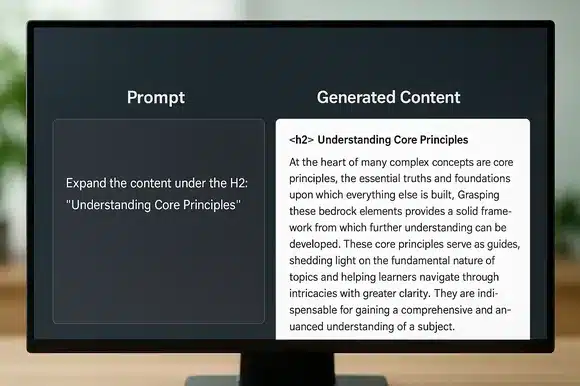
Each step in this workflow supports better keyword integration. For instance, SEO for blog posts may be emphasized in an application section, while SEO AI writer fits best when describing how the system executes your structure. This deliberate placement improves keyword density, avoids repetition, and enhances semantic context — which search engines now prioritize heavily when ranking content.
Equally important, the structure naturally aligns with user behavior. Readers prefer content that’s clear, logically ordered, and easy to scan — especially on mobile. By building each section as a self-contained piece that connects cleanly to the next, this workflow improves readability, boosts time on page, and strengthens trust signals for both humans and algorithms.
If you’re new to building a long-term SEO content strategy, this prompt-based method offers immediate benefits. You can start small — one section at a time — and build confidence as you go. The more you apply the system, the more consistent, efficient, and search-ready your writing becomes. This is how scalable SEO content is created — not in bulk, but in sequence, with strategy leading every step.
Why Prompt-Driven Content Improves SEO

Modern SEO demands more than keyword repetition — it rewards structure, clarity, and content that directly aligns with user intent. The prompt-driven workflow in SEOBoostAI is engineered to meet these requirements by guiding the AI to create your article section by section, with each part serving a specific purpose. Rather than generating a single, all-in-one draft, this system allows you to control the direction of each section, ensuring stronger alignment between your goals and what the user is actually searching for.
This method excels in building **SEO-friendly article structure**. Each heading, paragraph, and supporting point is developed with clear context, making it easier for search engines to identify the relationships between topics, subtopics, and target keywords. When your article flows logically and remains topically relevant throughout, search engines interpret it as more authoritative, leading to better rankings across both short-tail and long-tail keyword variations.
The workflow also improves the way keywords are distributed and integrated. Rather than overloading a single paragraph with multiple terms, this approach assigns each keyword to a logical section based on search behavior and reader expectation. For instance, SEO content writing may be introduced in strategic planning sections, while SEO AI writer is best used when discussing the system’s automation or execution phase. This creates intentional keyword placement that strengthens on-page signals without compromising flow or tone.
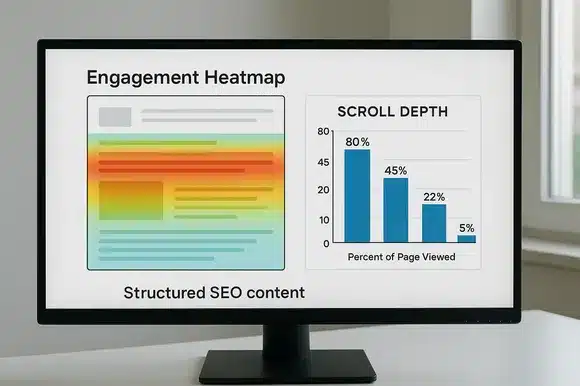
Equally important is the impact this system has on user behavior. Structured articles are naturally easier to digest. Each section has a headline that reflects the user’s search intent, and the paragraphs are short, scannable, and purposeful. This encourages deeper engagement — longer time on page, reduced bounce rate, and more scroll depth. These behavioral signals are increasingly important in Google’s ranking algorithms, making them just as critical as your on-page SEO elements.
The prompt-by-prompt workflow also makes it easier to maintain voice and tone consistency. Because each section is developed in isolation but within a defined structure, your messaging stays focused — especially important when building authority over time. This consistency improves brand trust, which in turn contributes to repeat engagement, backlink potential, and increased domain relevance.
If you're just starting to implement SEO for content writing, this method offers a structured, supportive path to success. You’re not left guessing — you’re leading the AI step by step, turning a complex process into a predictable system. Over time, this enables you to build an effective, scalable SEO content strategy that supports rankings, engagement, and long-term visibility — all without relying on plugins, templates, or trial-and-error writing habits.
How to Use the Prompt-Based Expansion Method
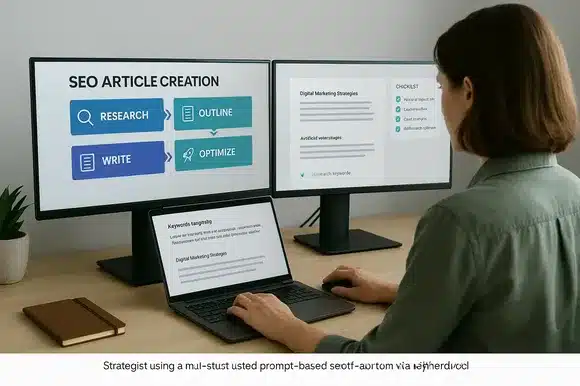
The prompt-based expansion method in SEOBoostAI transforms SEO content writing into a structured, repeatable process that’s ideal for both beginners and experienced creators. Instead of relying on one-shot AI output, you manually guide each phase of the article using targeted prompts. This hands-on workflow ensures clarity, optimization, and alignment with both search engines and reader expectations.
By following a fixed series of steps, you reduce guesswork and gain full control over your article’s structure and SEO performance. Each phase — from planning to publication — is designed to improve consistency, eliminate inefficiencies, and make your content more effective in competitive search environments.
Step 1: Define Your Topic and Intent
Clarity begins with purpose. Choose a topic that reflects your audience’s needs and your business goals. Are you trying to rank for a competitive term? Build topical authority? Drive conversions? Defining this upfront ensures your structure, tone, and keyword targets all work toward a single objective. This foundational step shapes your entire SEO content strategy.
Step 2: Assign and Align Keywords
Keyword alignment is not just about inclusion — it’s about intent. Select one clear primary keyword, then 2–4 secondary phrases that support deeper coverage of the topic. For example, pairing “SEO content writing” with terms like “SEO AI writer” and “SEO for blog posts” helps you satisfy broader search queries while strengthening semantic relevance. Assign each keyword to a logical section based on where it adds value, not just where it fits grammatically.
Step 3: Generate the Title, Subtitle, and Introduction
This is where your article starts ranking — and starts converting. The first prompt generates your H1 title, H2 subtitle, and the opening paragraph. Use this section to hook the reader, establish search relevance, and introduce the topic using your primary keyword. This section must be carefully reviewed, as it influences both user engagement and how search engines categorize your content.
Step 4: Expand the Article Section by Section
Build your content one prompt at a time. Each major part of your article — from definitions and explanations to benefits, steps, or conclusions — is created using a single prompt. This keeps each section clean, focused, and easier to optimize. It also allows you to apply different tones or styles where needed, helping your article feel cohesive but dynamic.
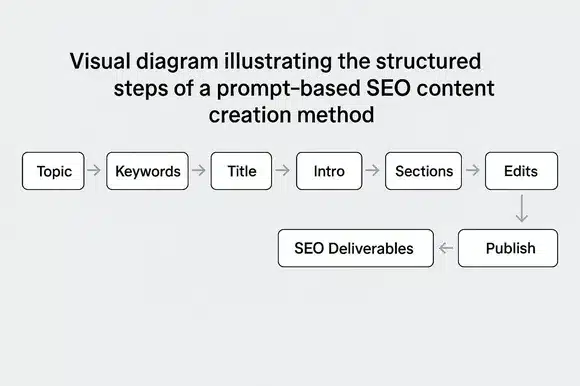
Step 5: Review and Refine in Real Time
Editing isn’t an afterthought — it’s part of the process. After each section is generated, you have the opportunity to fine-tune tone, transition flow, or keyword density. This prevents issues from compounding and ensures your content remains reader-friendly, optimized, and true to your brand voice. The goal is to improve as you go, not to patch everything at the end.
Step 6: Add SEO Deliverables and Structured Data
This is what turns your article into a fully optimized asset. Once the body of the article is complete, generate your Meta Title, Meta Description, and supporting Schema. For most articles, this includes WebPage, BreadcrumbList, and optional FAQPage markup. These deliverables improve how your content appears in search and ensure it can be indexed and interpreted properly by crawlers.
Step 7: Publish, Promote, and Repurpose
Publishing is just the beginning. Once live, promote your article via social media, internal linking, newsletters, and repurposing opportunities. The structured format created by SEOBoostAI makes it easy to slice your content into derivative formats — such as posts, carousels, email tips, or downloadable PDFs — multiplying your return on effort while preserving your SEO footprint.
Let’s say you’re writing an article titled “Email Marketing for Coaches.” After assigning keywords like “email marketing strategies” and “coach email templates,” you would use a separate prompt for each major section — such as an overview, a list of tips, a section on common mistakes, and a call to action. The result is a clean, focused, and search-optimized article that ranks better and reads more naturally — built from the ground up with structure and strategy.
Best Practices and Common Mistakes to Avoid

Even with a powerful system like SEOBoostAI, results depend on how effectively you apply the method. For content creators — especially those learning SEO content writing — following proven best practices and avoiding common pitfalls is essential. These guidelines will help you extract the full value of the prompt-driven workflow, ensuring that your articles are optimized for both performance and readability.
✅ Best Practices
1. Follow the Prompt Sequence from Start to Finish
Each section of your article builds on the one before it. Skipping steps or jumping around disrupts the structure, weakens keyword distribution, and confuses readers. Commit to a linear workflow — prompt by prompt — to maintain cohesion and SEO clarity throughout the piece.
2. Assign Keywords Strategically — Not Randomly
Rather than forcing keywords into every section, assign each one to a place where it naturally fits. For example, use “SEO for blog posts” in sections that deal with application or examples, and reserve “SEO AI writer” for those discussing execution. This improves keyword depth, avoids dilution, and supports better on-page optimization.
3. Refine Every Section Before Moving On
Don’t wait until the end to edit. After generating each section, take a moment to refine tone, improve transitions, and adjust keyword placement. This real-time editing approach creates a more polished final product and reduces rework later.
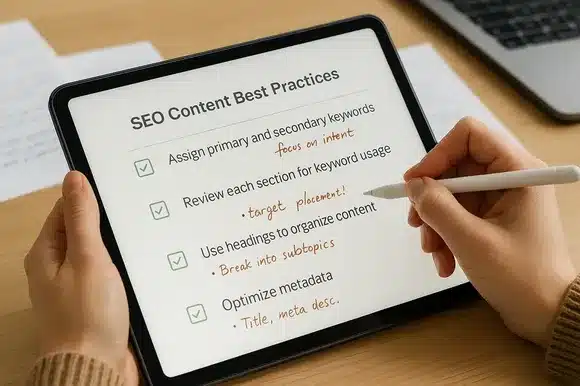
4. Write in Short, Focused Paragraphs
Long blocks of text are hard to read and harder to rank. Keep paragraphs between 2–4 sentences, focusing on a single point. This improves scanability, increases mobile readability, and supports better semantic interpretation by search engines.
5. Let the Framework Guide You — But Customize with Insight
SEOBoostAI provides structure, formatting, and keyword logic, but your voice, insight, and expertise make the content valuable. Blend the system’s automation with your own perspective to produce authentic, high-performing content.
6. Use Section Headings to Match Search Intent
Make sure each <h2> and <h3> heading directly reflects what the reader is searching for. This helps search engines understand your article’s topical structure and improves relevance for long-tail queries.
⚠️ Common Mistakes to Avoid
1. Overloading the Introduction with Keywords
Many beginners try to cram all their keywords into the first paragraph. This makes the introduction sound robotic and diminishes its persuasive power. Spread your keywords strategically across relevant sections to maintain natural flow and semantic clarity.
2. Skipping the Real-Time Review Phase
If you skip reviews after each prompt, small issues compound — from inconsistent tone to misaligned keywords. Make section-by-section review a mandatory part of your workflow.

3. Using Generic Prompts Without Direction
Vague or lazy prompts lead to vague or lazy content. If your prompt lacks specificity — such as section intent, voice, or keyword focus — the AI will return shallow output. The quality of your input directly determines the quality of your output.
4. Neglecting SEO Deliverables After Writing
Even the best-written content won’t rank without a proper Meta Title, Description, and Schema. Ensure you complete the full workflow — including technical SEO — before publishing.
5. Writing for Algorithms Instead of Humans
SEO isn’t just about ranking — it’s about solving problems, answering questions, and building trust. Don’t obsess over density or keyword counts. Write to inform, guide, or inspire real readers, and optimization will follow naturally.
By combining disciplined structure with smart content strategy, the SEOBoostAI workflow empowers you to write content that ranks, resonates, and converts. These best practices — and the mistakes they counter — will keep your output clean, intentional, and effective from the first prompt to the final publish.
Frequently Asked Questions
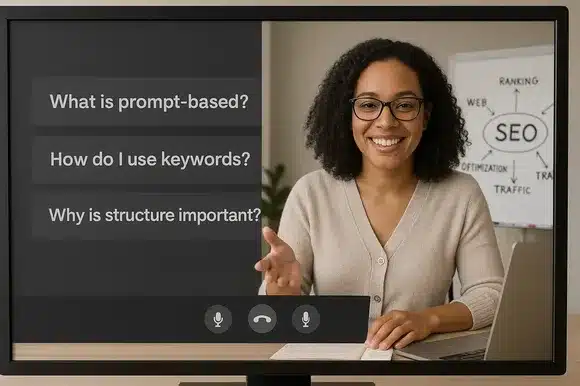
What is the Prompt-Based Expansion Method?
It’s a structured approach to SEO content writing where each part of your article is developed using a dedicated prompt. Instead of writing the entire article at once, you expand it step-by-step — from the introduction to the conclusion — giving each section focus, clarity, and SEO alignment. This method is at the core of how SEOBoostAI helps users create professional, search-ready content with consistency.
How does this workflow improve SEO?
By isolating and optimizing one section at a time, the prompt-based workflow improves content structure, keyword distribution, and semantic depth. Search engines prioritize content that’s well-organized, easy to scan, and closely aligned with search intent. This method also improves behavioral signals — like engagement and time on page — which contribute to stronger rankings over time.
Do I need to be an experienced writer to use this system?
No. SEOBoostAI was designed specifically to support beginners. The structured, prompt-by-prompt workflow eliminates overwhelm by guiding you through each step of the article creation process. Whether you're writing your first blog post or optimizing a high-stakes landing page, the system gives you clear direction and professional output without requiring advanced SEO knowledge.
What kinds of content can I create using this method?
The prompt-based expansion method works for virtually all types of SEO content — including blog posts, long-form guides, product and service pages, landing pages, and educational resources. The structure adapts to your keyword goals, audience needs, and content objectives. It’s flexible, scalable, and optimized for both human readers and search engines.
Does the system handle optimization automatically?
The system helps automate structure, flow, and keyword targeting during content creation. However, after the body of the article is complete, you’ll still need to generate SEO deliverables like your Meta Title, Meta Description, and Schema. These are the final elements that prepare your content for indexing and visibility. The good news: SEOBoostAI walks you through that step as part of the standard workflow.